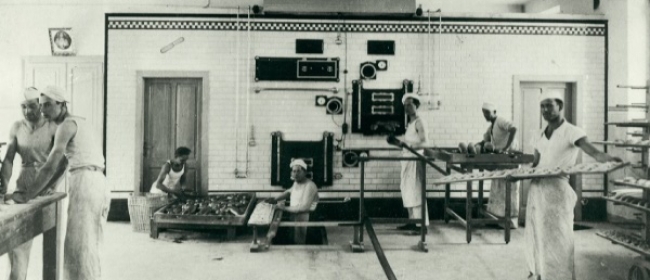Roma Pan Pizza:
History and Evolution
Initially, this product was heavy and full of fat. over the years, it has evolved and people have identfied the product as the most digestible and healthiest type of pizza.
Initially, this product was heavy and full of fat. over the years, it has evolved and people have identfied the product as the most digestible and healthiest type of pizza.
Description
Roman Pizza in Teglia or Roman Pan Pizza is a roman cuisine gastronomic product. Once being cooked in the classic baking tray, the product is laid on the pizza by the slice counters or street food counters in order to sell slices of pizza.
The pizza fragrance and digestibility let customers to choose among a variety of pizzas, often flavoured with gourmet dressings, or take part in real tastings.
This product is a suitable base for all recipes thanks to its crunchiness and the dough high hydration, which contributes to the formation of many balls (gas) during the rising process.
The real and authentic Roman Pan Pizza is characterised by a lower crispy layer covered with a well-risen and soft crumb with the typical pronounced holes.
History
Pan Pizza or al Testo developed at the very beginning of 1900 in Tuscany. At that time, old bakers and housewives used to make this type of pizza and other bakery products for family consumption. The product was prepared in a rounded or rectangular baking tray and cooked on a wood fire with the fire off or on low-heat.
In the past, this product was unfortunately different to the current Pan Pizza: the rising process used to last for a short time (2 or 3 hours at the most) and the dough was very dry (low hydration). It follows that a greater quantity of flour was used as well as a large quantity of lard (up to 3 grams of pig lard for each kilogram of flour).
In addition, a substantial part of sugar was added to the dough to anticipate the colouring and avoid the product dryness while cooking.
This old type of production made the product barely digestible and very calorific.

In the ‘70s, Umbrian inhabitants or rather inhabitants from Terni gradually started to open pizzerias in Rome until they achieved resounding success.
The first real evolution occurred in 1981, when Pan Pizza took the nickname of alla Romana thanks to Corrado Di Marco’s original point of view. Di Marco came from an old bread maker family and founded the Pizzasnella Di Marco company.
It was Di Marco himself to revolutionise the Pan Pizza. He understood that people food preferences and habits were changing very quickly. At the beginning of the ‘80s, the growing sedentary lifestyle and people interest in their own nutrition influenced the way food was prepared.
The Pan Pizza restyling (dough and making) was based on these important and significant changes:
-
Maturation goes from 2-3 hours to 24/7.
-
Dough hydrations are estimated from a maximum of 60% to a minimum of 80%.
-
Usage of better quality flours (suitable for long rising processes).
-
Replacement of lard with soya: far less calorific and much healthier; provides the same outcome of a crispy and fragrant pizza.
-
No sugar.
-
Fat used: low quantities of extra virgin olive oil only.
That’s how the Roman Pan Pizza was made: crispy on the outside and soft with large bubbles inside the dough. The pizza can not only remain fresh on the counter thanks to the high percentage of water in the dough but also be heat it up several times without losing its crunchiness.
Following this period of transformation, the market changed completely as almost everyone stopped using the lard and the Roman Pan Pizza became very popular all over the world thanks to its high gastronomic quality.
After more than 30 years, this total change is still a successful method used by several pizzerias given its innovative and forward-looking features.
Among today wide variety of pizzas, it is also possible to try stuffed pizzas (made with two pizza layers and a heart of ingredients inside) or pizze fredde (cold pizzas) seasoned with raw ingredients, which are added after the cooking so that the product on the counter will last longer.
Dough
The Roman Pan Pizza dough production needs to be accurate and correct. The dough maturation and its completion are very important processes to get a highly digestible and fragrant product.
In the past, biga indirect dough was the most popular technique used for mixtures. Today, instead, the most common methodologies used are direct dough and long maturation with a minimum of 24 hours.
The flours used for the Pan Pizza need to be strong (W high) to support long lasting maturation and very high hydration processes that can reach up to 90%.
The soft wheat is the most used together with a small percentage of soya flour. Also, the market offers a mix of several types of suitable and well measured flours.
Recipes
Roman Pan Pizza recipes have changed overtime: years ago, people had classic tastes while now they choose and focus on the study of refined and gourmet seasonings.
The ingredients for the baking tray pizza take a long time to cook (up to 10/12 minutes) and need to be kept in a good state as they remain on the pizza counter for a long time. Baking tray pizza ingredients demand, therefore, more attention compared with classic pizza ingredients.
In this particular case, it is important not to let the ingredients to dry in the oven during the cooking.
This is the reason why cold fillings are often used to preserve tastes and humidity of some seasonings. The chromatic aspect should not be underestimated as the baking tray pizza is a showcase product. In addition to taste, flavours and product consistency, a great attention has also been given to the way pizza is exposed as the bright and voluminous ingredients may prove.
Cooking
This product is cooked in electrical ovens, where resistance power is set on the sky (upper surface) and plate (bottom surface).
The cooking timing of this product compared with other types of pizza is longer due to the baking tray placed between the hob and the dough.
During the cooking, there is time for the Pan Pizza to dry, eliminate big quantity of water in the dough and get the crispy typical aspect.
The oven for the Roman Pan Pizza has opposite settings-out compared with: Round Pizza, Pizza in Pala or Roman Pinsa.
There must be more resistance power in the plate than in the sky.
New Roman Pan Pizza
The Roman Pan Pizza is still very popular and ready for a new change by Di Marco business, whose passion and bond to the product have help to further improve it over the years.
The Teglia Romana new mix of flours has been made to obtain a greater number of hydrations (up to 90%) and a more digestible, crumblier and lighter product.
There are specific courses planned to best learn the making process.
The search of optimisation is definitely one of the basic steps towards quality and many businesses are (luckily) aware of this.
If you want to attend a free demonstration of the product or have info about the mix or courses:









